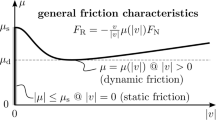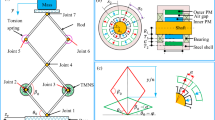Abstract
A new equivalent center of mass model of FPBs (friction pendulum bearings) is introduced, and based on this model, coefficient j of the equivalent center of mass separating from the sliding surface is defined. It is thought in theory that j has a significant impact on the isolation parameter of FPBs, since the equivalent post-yielding stiffness and friction coefficients are not simply determined by sliding radius and sliding friction pairs. The results of numerical simulation analysis using ABAQUS conducted on two groups of FPBs support this viewpoint. For FPBs with the same sliding radius and sliding friction pairs, the FPB modules of structural analysis software such as ETABS could only distinguish the equivalent transformation using j one by one. The seismic response data obtained in a base isolation calculation example of FPBs are very different, which reveals that j’s impact on the isolation effectiveness of FPBs cannot be ignored. The introduction of j will help improve the classical structural theory of FPBs and the weak points of structural analysis software based on this theory, which is important in achieving more accurate analyses in structural design.
Similar content being viewed by others
References
EN 15129 (2009), “Anti-seismic Devices,” European Committee for Standardizatio, European.
Fan LC and Wang ZQ (2001), “Seismic Isolation Device Mechanics Characteristic and Analytical Model,” in Seismic Design of Bridges, Chapter 2, China Communications Press, BeiJing. (in Chinese)
GB50011 (2010), Code for Seismic Design of Buildings, China Architecture & Building Press, Beijing. (in Chinese)
Ge N, Su YP, Wang XG and Zhou XY (2010), “Disturbance from Vertical Oscillation to Siesmic Isolation Behavior of FPS System,” Earthquake Resistant Engineering and Retrofitting, 32(4): 24–25. (in Chinese)
Gong J, Deng XS and Zhou Y (2011), “Study on Theoretical Analysis and Numerical Simulation of Friction Pendulum Bearing,” Journal of Disaster Prevention and Mitigation Engineering, 31(1): 56–62. (in Chinese)
Gong J and Zhou Y (2010), “State of the Art and Prospect of the Research and Application of Friction Pendulum IsolationTechnology(I) -Types and Performance of Friction Pendulum Bearings,” Earthquake Resistant Engineering and Retrofitting, 32(3): 1–10. (in Chinese)
JTG-T B02-01 (2008), Guidelines for Seismic Design of Highway Bridges, Communications Press, Beijing. (in Chinese)
Kim YS and Yun CB (2007), “Seismic Response Characteristics of Bridges Using Double Concave Friction Pendulum Bearings with Tri-linear Behavior,” Engineering Structures, (29): 3082–3093.
Li DW, Wang DW and Zhou XY (1999), “Autonomous FPS and Its Performance Analysis,” Vibation and Shock, 18(1): 23–25. (in Chinese)
Li DW, Zhou XY and Wang DW (2001), “Further Analysis for the Vibration Performances of Friction Pendulum Systems,” Journal of Vibration Engineering, 14(3): 330–333. (in Chinese)
Magliulo G, Maddaloni G and Petrone C (2014), “Influence of Earthquake Direction on the Seismic Response of Irregular Plan RC Frame Buildings,” Earthquake Engineering and Engineering Vibration, 13(2): 243–256.
Okamura S and Fujita S (2007), “Motion Analysis of Pendulum Type Isolation Systems during Earthquakes,” Pressure Vessel Technology, (129): 507–515.
Peng TB, Li JZ and Fan LC (2007), “Development and Application of Double Spherical Seismic Bearing,” Journal of TongJi University (Natural Science), 35(2): 176–180. (in Chinese)
Tsai CS, Su HC and Chiang TC (2014), “Equivalent Series System to Model a Multiple Friction Pendulum System with Numerous Sliding Interfaces for Seismic Analyses,” Earthquake Engineering and Engineering Vibration, 13(1): 85–99.
Wang JQ, Chen LH, You QY and Zhao Z (2011), “Influence of Radius of Spherical Surface on the Seismic Responses of Base-isolated Structure with Friction Pendulum System,” Journal of Earthquake Engineering and Engineering Vibration, 31(4): 132–136. (in Chinese)
Wang JQ, Guan PW and Li DW (2005), “Analysis of Seismic Response of Base-isolated Structures with Friction Pendulum System under Bilateral Ground Motions,” World Earthquake Engineering, 21(3): 11–15. (in Chinese)
Wen L, Wang SG, Du DS and Xu LP (2009), “Controlling Analysis of Friction Pendulum System for the Seismic Isolation of Liquid Storage Tanks,” World Earthquake Engineering, 25(4): 161–166. (in Chinese)
Wu W (2007), “Analysis of Seismic Isolated Structurs Using Friction Pendulum Bearings,” Beijing Jiaotong University, Beijing. (in Chinese)
Xia JY, Hao HX, Ning XL and Hu YX (2012), “The Principle of Equivalent Center of Mass of FPB & Superstructure,” Advanced Materials Research, 594-597: 982–986. (in Chinese)
Zayas V, Low S and Mahin S (1987), “The FPS Earthquake Resisting System,” Technical Report UCB/ EERC-87/01, University of California, Berkeley.
Zayas V, Low S and Mahin S (1990), “A Simple Pendulum Technique for Achieving Seismic Isolation,” Earthquake Spectra, (6): 317–334.
Author information
Authors and Affiliations
Corresponding author
Additional information
Supported by: 973 Program under Grant No.2012CB723304; Program for Changjiang Scholars and Innovative Research Team in University; National Science Foundation Program under Grant No. 91315301-07
Rights and permissions
About this article
Cite this article
Xia, J., Ning, X., Tan, P. et al. Impact of the equivalent center of mass separating from the sliding surface on the isolation performance of friction pendulum bearings. Earthq. Eng. Eng. Vib. 14, 695–702 (2015). https://doi.org/10.1007/s11803-015-0054-x
Received:
Accepted:
Published:
Issue Date:
DOI: https://doi.org/10.1007/s11803-015-0054-x




